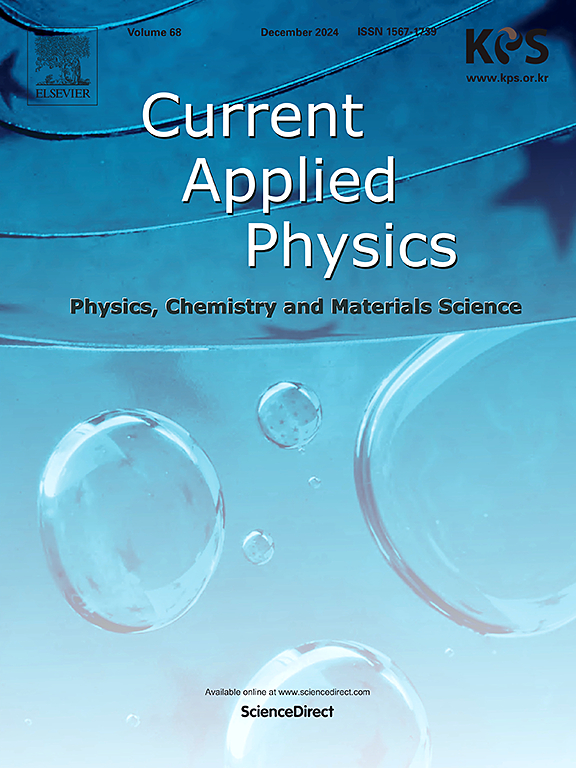Structural and optoelectronic analysis of a novel perylene diimide as a light-harvesting material for dye-sensitized solar cells
IF 3.1
4区 物理与天体物理
Q3 MATERIALS SCIENCE, MULTIDISCIPLINARY
引用次数: 0
Abstract
Perylene diimides (PDIs) have emerged as an excellent n-type semiconductor substitute for fullerenes in energy devices. A novel PDI, N, N′-bis-(2-phenylethyl)-3,4,9,10-perylene bis(dicarboximide)(PDEA), was synthesized and its structure was thoroughly characterized using Fourier transforms infrared spectroscopy (FTIR), High-resolution mass spectroscopy (HRMS), Proton Nuclear magnetic resonance (1H NMR). The optical properties of the PDI were evaluated using UV–visible, and Photoluminescence (PL) spectroscopic techniques. The UV–Visible spectrum of PDEA exhibited a broad absorption band in the visible range (400–800 nm), with yellowish-green fluorescence emission under a UV lamp. The structure of PDEA was optimized using Density Functional Theory (DFT) with the B3LYP/6-31G (d, p) basis set, and its optoelectronic properties were evaluated in a variety of solvents of different polarities. Further, Cyclic Voltammetry (CV) was utilized to examine the electrochemical redox behaviour of PDEA in acetonitrile which was observed to be one-electron quasi-reversible. The as-synthesized PDEA was used to fabricate the DSSC and was found to exhibit a good photovoltaic performance with a fill factor (FF) of 72, an open-circuit voltage (Voc) of 0.52 V, a PCE (power conversion efficiency) of 0.63 %, and a Jsc (short circuit current density) of 1.67 mA/cm2. The above-mentioned characteristics of the PDEA may have applications in photovoltaics, fluorescence-based detectors, n-channel field-effect transistors, and other related areas.

一种新型染料敏化太阳能电池光收集材料苝二亚胺的结构与光电分析
苝二酰亚胺(pdi)已成为一种替代富勒烯的n型半导体材料。合成了一种新型PDI N, N ' -双-(2-苯乙基)-3,4,9,10-苝双(二碳酰亚胺)(PDEA),并利用傅里叶变换红外光谱(FTIR)、高分辨率质谱(HRMS)、质子核磁共振(1H NMR)对其结构进行了表征。利用紫外可见光谱和光致发光(PL)光谱技术对PDI的光学性能进行了评价。PDEA的紫外可见光谱在400 ~ 800 nm的可见光范围内具有较宽的吸收带,在紫外灯下发出黄绿色荧光。以B3LYP/6-31G (d, p)基为基础,利用密度泛函理论(DFT)优化了PDEA的结构,并对其在不同极性溶剂中的光电性能进行了评价。利用循环伏安法(CV)考察了PDEA在乙腈中的电化学氧化还原行为,发现其具有单电子准可逆的电化学氧化还原行为。将合成的PDEA用于制备DSSC,发现其具有良好的光伏性能,填充因子(FF)为72,开路电压(Voc)为0.52 V,功率转换效率(PCE)为0.63%,短路电流密度(Jsc)为1.67 mA/cm2。PDEA的上述特性可以应用于光伏、荧光探测器、n沟道场效应晶体管和其他相关领域。
本文章由计算机程序翻译,如有差异,请以英文原文为准。
求助全文
约1分钟内获得全文
求助全文
来源期刊

Current Applied Physics
物理-材料科学:综合
CiteScore
4.80
自引率
0.00%
发文量
213
审稿时长
33 days
期刊介绍:
Current Applied Physics (Curr. Appl. Phys.) is a monthly published international journal covering all the fields of applied science investigating the physics of the advanced materials for future applications.
Other areas covered: Experimental and theoretical aspects of advanced materials and devices dealing with synthesis or structural chemistry, physical and electronic properties, photonics, engineering applications, and uniquely pertinent measurement or analytical techniques.
Current Applied Physics, published since 2001, covers physics, chemistry and materials science, including bio-materials, with their engineering aspects. It is a truly interdisciplinary journal opening a forum for scientists of all related fields, a unique point of the journal discriminating it from other worldwide and/or Pacific Rim applied physics journals.
Regular research papers, letters and review articles with contents meeting the scope of the journal will be considered for publication after peer review.
The Journal is owned by the Korean Physical Society.
 求助内容:
求助内容: 应助结果提醒方式:
应助结果提醒方式:


